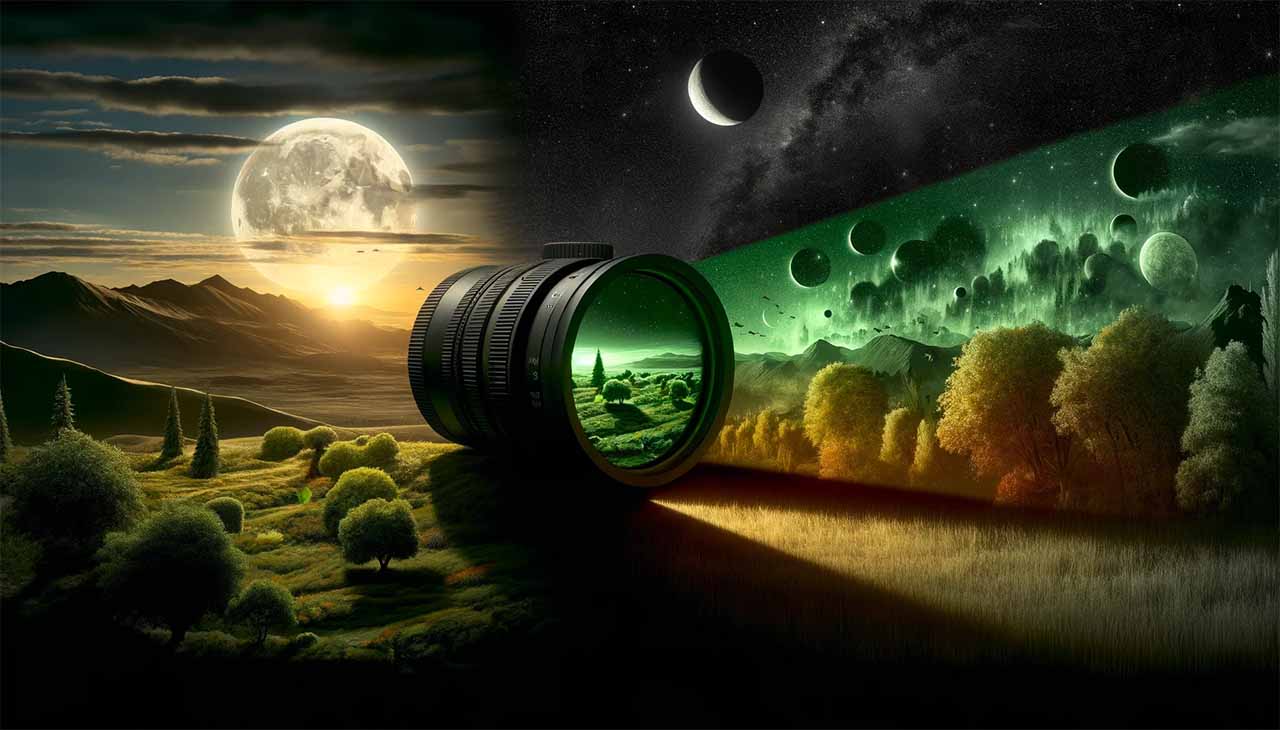From Twilight to Total Darkness: The Evolution of Night Vision Optics

Night vision optics have revolutionized the way we perceive and interact with the world after dusk. Their importance cannot be overstated in a variety of fields, from the military, where they are critical for surveillance and target detection, to wildlife observation, where they allow naturalists to study nocturnal creatures without disturbing their routines.
The evolution of night vision technology has been propelled by advancements in electrical engineering, photonics, and materials science. Early forms of night vision equipment relied on active infrared technology, where a source of infrared light was used to illuminate the scene. This technology was soon replaced by passive infrared devices, which detect the natural infrared radiation emitted by objects. The latest generations of night vision devices use image intensification and thermal imaging technologies, providing even better visibility in low light conditions. The journey from rudimentary devices to the sophisticated equipment we have today reflects our persistent human endeavor to unravel the mysteries of the night.
Early Developments in Night Vision Optics
The Invention of the First Night Vision Devices
The initial developments in night vision technology trace back to World War II. These early devices, known as “Generation 0,” employed active infrared technology. An infrared spotlight attached to a night vision device would illuminate the area of interest, and the reflected light, invisible to the naked eye, would be picked up by the device’s infrared-sensitive cathode tube, generating an image.
Limited Capabilities and Drawbacks
Despite these groundbreaking advancements, the first night vision devices had significant limitations. They required the use of an external infrared light source and could be detected by opposing forces using similar technology. Additionally, the images produced were often blurry and lacked detail. The short lifespan of the infrared cathode tube also posed a problem, frequently requiring replacement after only a few hours of use. Despite these drawbacks, the strategic advantage of being able to see in the dark was invaluable, sparking further research and development in this field.
World War II and the Advancement of Night Vision Technology
Military Applications and Innovations
During World War II, the military heavily relied on night vision devices. From navigating the treacherous terrains under the cover of night to detecting targets and avoiding surprise attacks, these devices played a pivotal role in strategic planning and operations. The U.S. Army, in particular, made significant strides in the development and application of night vision technology. Their Sniperscope, which was used extensively in the Korean War, and the later “Starlight scopes” of the Vietnam War, presented the transformative potential of this technology in warfare.
Infrared Technology and Its Impact
Infrared technology, forming the core of the early night vision devices, dramatically altered the dynamics of warfare and surveillance. It provided the ability to see images in dark conditions by detecting the heat given off by objects. This removed the dependency on available light, paving the way for operations to be carried out in total darkness. It also opened up new avenues in wildlife research, allowing observations of nocturnal animals in their natural habitats without causing disturbance. However, it had its shortcomings, such as the requirement for an external infrared light source and the ease of detection by similar devices. These factors spurred further innovation in night vision technology, leading to more advanced and stealthy systems in later years.
Cold War Era: Night Vision Goes Mainstream
Expansion of Night Vision Technology Beyond the Military
In the Cold War era, the use of night vision technology expanded beyond the military, becoming increasingly prevalent in several civilian applications. Law enforcement agencies began utilizing night vision devices for surveillance and tracking suspects during night time operations. Scientists and researchers saw the value of this technology in studying nocturnal wildlife, as it provided the ability to observe species in darkness without causing any disturbance. In addition, night vision devices found their way into the commercial market, with private security firms and even outdoor enthusiasts adopting the technology to navigate the darkness.
Improvements in Image Quality and Range
The Cold War period also saw significant improvements in the quality and range of images produced by night vision devices. Advancements in electronics and materials science led to the development of passive infrared devices that did not require an external light source and offered a longer range of vision. The image intensifier tube, a notable development, amplified available light to produce a bright and clear image, even in extremely low-light conditions. This technological leap dramatically increased the detail and clarity of images provided by night vision devices, making them an even more potent tool for military operations, surveillance activities, and wildlife observation.
Modern Advances in Night Vision Optics
Digital Night Vision and Thermal Imaging
With the advent of digital technology, night vision has taken a significant leap forward. Digital night vision devices capture an image, convert it into an electronic signal, and then produce an output on a screen. This technology offers several advantages, such as the ability to record images or video and better performance in low-contrast conditions. Thermal imaging is another remarkable advancement in this field. Unlike traditional night vision, thermal imaging does not rely on light. Instead, it detects heat emitted by objects, allowing users to see in complete darkness, through fog or smoke, and even in the daytime. This technology’s applications are vast, ranging from military and law enforcement to wildlife observation and search and rescue missions.
Miniaturization and Increased Accessibility
The miniaturization of night vision technology has led to the development of compact, lightweight devices that are easier to use and carry. This advancement has not only benefited military and law enforcement personnel but also outdoor enthusiasts, who can now more easily navigate the wilderness after sundown. The widespread availability of these devices has led to increased accessibility for the general public. Despite being a high-tech gadget, night vision devices are no longer a luxury exclusive to the military or law enforcement. They are now readily available in various forms, from night vision goggles to smartphone apps, broadening their appeal and usage across a range of applications.
Future Trends in Night Vision Technology
Enhanced Image Resolution and Clarity
As the demand for night vision technology grows, so does the pursuit for enhanced image resolution and clarity. Future night vision devices are anticipated to deliver images of extraordinary detail, even in the most challenging light conditions. Advanced sensors and image processing algorithms will play a critical role in this area, enabling sharper image capture and more accurate color representation. This will significantly improve the user’s ability to identify details and distinguish among objects, enhancing the overall utility and efficiency of night vision technology.
Integration with Other Technologies
The future of night vision technology also lies in its integration with other technologies. An exciting trend is the potential fusion of night vision with augmented reality (AR) and virtual reality (VR) systems. This could revolutionize a variety of fields, including military operations, law enforcement, wildlife research, and even gaming and entertainment. Additionally, we can expect to see more integration of night vision capabilities in everyday gadgets like smartphones and vehicles, further extending its range of applications. Night vision, combined with emerging technologies like AI and machine learning, could lead to smart systems capable of interpreting images and making predictions, adding another layer of functionality to this already transformative technology.


